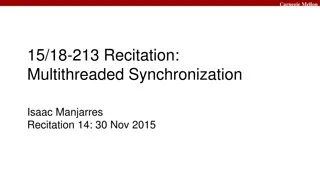Higher-Level Synchronization with Semaphores at Carnegie Mellon
Discover how Carnegie Mellon University explores higher-level synchronization primitives such as semaphores for effective thread management. Learn about the design and operations of semaphores, and compare them with traditional locking mechanisms. Dive into code examples and visual illustrations to grasp the concepts better.
Download Presentation

Please find below an Image/Link to download the presentation.
The content on the website is provided AS IS for your information and personal use only. It may not be sold, licensed, or shared on other websites without obtaining consent from the author.If you encounter any issues during the download, it is possible that the publisher has removed the file from their server.
You are allowed to download the files provided on this website for personal or commercial use, subject to the condition that they are used lawfully. All files are the property of their respective owners.
The content on the website is provided AS IS for your information and personal use only. It may not be sold, licensed, or shared on other websites without obtaining consent from the author.
E N D
Presentation Transcript
Carnegie Mellon Synchronization Semaphores Some of the slides are adapted from Matt Welsh s.
Carnegie Mellon Higher-level synchronization primitives We have looked at one synchronization primitive: locks Locks are useful for many things, but sometimes programs have different requirements. Examples? Say we had a shared variable where we wanted any number of threads to read the variable, but only one thread to write it. How would you do this with locks? Reader() { lock(lockvar); mycopy = shared_var; unlock(lockvar); return mycopy; } Writer() { lock(lockvar); shared_var = NEW_VALUE; unlock(lockvar); } What's wrong with this code?
Carnegie Mellon Semaphores Semaphore Higher-level synchronization construct Designed by Edsger Dijkstra in the 1960's. Semaphore is a shared counter. Initialized Two operations on semaphores: P() or down() or wait() From Dutch proeberen , meaning test Atomic action: Wait for semaphore value to become > 0, then decrement it V() or up() or post() or signal() From Dutch verhogen , meaning increment Atomic action: Increments semaphore value by 1.
Carnegie Mellon Semaphore initialized with 1. Semaphore
Carnegie Mellon Thread 1 calls wait() and proceeds Thread 1 wait() Semaphore Semaphore value before: 1 Semaphore value after: 0
Carnegie Mellon Thread 2 calls wait() and blocks Thread 2 wait() Z z z Semaphore Semaphore value before: 0 Semaphore value after: -1
Carnegie Mellon Thread 3 calls signal() Thread 3 signal() Z z z Thread 2 wait() Semaphore Semaphore value before: -1 Semaphore value after: 0
Carnegie Mellon Thread 4 calls signal() and proceeds Thread 4 signal() Semaphore Semaphore value before: 0 Semaphore value after: 1
Carnegie Mellon C Semaphore Operations Pthreads functions: #include <semaphore.h> int sem_init(sem_t *s, 0, unsigned int val);} /* s = val */ int sem_wait(sem_t *s); /* P(s), down(s), wait(s) */ int sem_post(sem_t *s); /* V(s), up(s), signal(s)*/
Carnegie Mellon Semaphore Example Semaphores can be used to implement locks: semaphore my_semaphore; init(my_semaphore, 1); int withdraw(account, amount) { wait(my_semaphore); balance = get_balance(account); balance -= amount; put_balance(account, balance); signal(my_semaphore); return balance; } critical section A semaphore where the counter value is only 0 or 1 is called a binary semaphore.
Carnegie Mellon Simple Semaphore Implementation struct semaphore { int val; threadlist L; // List of threads waiting for semaphore } init(semaphore s, int initval): s.val= initval; wait(semaphore s): //Wait until > 0 then decrement if (s.val <= 0) { add this thread to S.L; block(this thread); } s.val = s.val -1; return; signal(semaphore s): //Increment and wake up next thread s.val = s.val + 1; if (s.L is nonempty) { remove a thread T from S.L; What's wrong with this picture??? wakeup(T); }
Carnegie Mellon Simple Semaphore Implementation struct semaphore { int val; threadlist L; // List of threads waiting for semaphore } init(semaphore s, int initval): s.val= initval; wait(semaphore s): //Wait until > 0 then decrement if (s.val <= 0) { add this thread to S.L; block(this thread); } s.val = s.val -1; return; init(), wait() and signal() must be atomic actions! signal(semaphore s): //Increment and wake up next thread s.val = s.val + 1; if (s.L is nonempty) { remove a thread T from S.L; wakeup(T); } What's wrong with this picture???
Carnegie Mellon Semaphore Implementation How do we ensure that the semaphore implementation is atomic? One approach: Make them system calls, and ensure only one wait() or signal() operation can be executed by any process at a time. This effectively puts a lock around the wait() and signal() operations themselves! Easy to do by disabling interrupts in the wait() and signal() calls. Another approach: Use hardware support E.g. cmpxchg instruction
Carnegie Mellon OK, but why are semaphores useful? A binary semaphore (counter is always 0 or 1) is basically a lock. The real value of semaphores becomes apparent when the counter can be initialized to a value other than 0 or 1. Say we initialize a semaphore's counter to 50. What does this mean about wait() and signal() operations?
Carnegie Mellon The Producer/Consumer Problem Also called the Bounded Buffer problem. zzzzz.... Producer Consumer Producer pushes items into the buffer. Consumer pulls items from the buffer. Producer needs to wait when buffer is full. Consumer needs to wait when the buffer is empty.
Carnegie Mellon One implementation... Producer Consumer int count = 0; Consumer Thread Producer Thread Consumer() { int item; while (TRUE) { if (count == 0) sleep(); item = removeitem(); count = count 1; if (count == N-1) wakeup(producer); eat(item); } } Producer() { int item; while (TRUE) { item = produce(); if (count == N) sleep(); insertitem(item); count = count + 1; if (count == 1) wakeup(consumer); } } What if we context switch right here??
Carnegie Mellon A fix using semaphores Producer Consumer semaphore mutex; init(mutex,1); semaphore full; init(full,0); // N: size of the buffer semaphore empty; init(empty,N); Producer Thread Consumer Thread Producer() { int item; while (TRUE) { item = produce(); wait(empty); wait(mutex); insertitem(item); signal(mutex); signal(full); } } Consumer() { int item; while (TRUE) { wait(full); wait(mutex); item = removeitem(); signal(mutex); signal(empty); eat(item); } }
Carnegie Mellon Reader/Writers Let's go back to the problem at the beginning of lecture. Single shared object Want to allow any number of threads to read simultaneously But, only one thread should be able to write to the object at a time (And, not interfere with any readers...)
Carnegie Mellon Readers-Writers Problem W1 R1 Read/ Write Access Read-only Access W2 R2 W3 R3 Problem statement: Reader threads only read the object Writer threads modify the object (read/write access) Writers must have exclusive access to the object Unlimited number of readers can access the object Occurs frequently in real systems, e.g., Online airline reservation system Multithreaded caching Web proxy
Carnegie Mellon Readers/Writers Examples W1 R1 W2 R2 W3 R3 W1 R1 W2 R2 W3 R3
Carnegie Mellon Reader/Writers Why the test here?? Reader Thread semaphore mutex; init(mutex,1); semaphore write; init(write,1); int readcount = 0; Reader() { wait(mutex); readcount++; if (readcount == 1) { wait(write); } signal(mutex); do_read(); wait(mutex); readcount--; if (readcount == 0) { signal(write); } signal(mutex); } Writer Thread Writer(){ wait(write); do_write(); signal(write); } A Reader should only wait for a Writer to complete its do_write(). A Reader should not wait for other Readers to complete their do_read(). The Writer should wait for the other Writers to complete their do_write(). The Writer should wait for all the Readers to complete their do_read().
Carnegie Mellon Summary signal(sem); never blocks! It always proceeds wait(sem); may block Would block if semaphore s current value is 0. Would proceed if semaphore s current value > 0, after decrementing it. init(sem, n); Would initialize semaphore to n. Semaphore value is not directly accessible. if (sem == i) type of comparisons are not allowed.
Carnegie Mellon Synchronization Synchronization Patterns Slides are created from The Little Book of Semaphores.
Carnegie Mellon Semaphore review Semaphore
Carnegie Mellon Signalling Possibly the simplest use for a semaphore is signalling. one thread sends a signal to another thread to indicate that something has happened. Signalling makes it possible to guarantee that a section of code in one thread will run before a section of code in another thread; in other words, it solves the serialization problem. The following examples are taken from: The Little Book of Semaphores http://greenteapress.com/wp/semaphores/
Carnegie Mellon Signalling Imagine that a1 reads a line from a file, and b1 displays the line on the screen. The semaphore should guarantee that Thread A has completed a1 before Thread B begins b1. Thread A Thread B statement a1; statement b1;
Carnegie Mellon Signalling Imagine that a1 reads a line from a file, and b1 displays the line on the screen. The semaphore in this program guarantees that Thread A has completed a1 before Thread B begins b1. if thread B gets to the wait statement first, it will find the initial value, zero, and it will block. Then when Thread A signals, Thread B proceeds. if Thread A gets to the signal first then the value of the semaphore will be incremented, and when Thread B gets to the wait, it will proceed immediately. Either way, the order of a1 and b1 is guaranteed. semaphore sem; init(sem,0); Thread A Thread B statement a1; signal(sem); wait(sem); statement b1;
Carnegie Mellon Rendezvous Generalize the signal pattern so that it works both ways. Thread A has to wait for Thread B and vice versa. Guarantee that a1 happens before b2 and b1 happens before a2. Your solution should not enforce too many constraints. Don t care about the order of a1 and b1. Either order should be possible. Two threads rendezvous at a point of execution, and neither is allowed to proceed until both have arrived. Thread A Thread B statement a1; statement a2; statement b1; statement b2;
Carnegie Mellon Rendezvous - Hint Generalize the signal pattern so that it works both ways. Thread A has to wait for Thread B and vice versa. Guarantee that a1 happens before b2 and b1 happens before a2. Your solution should not enforce too many constraints. Don t care about the order of a1 and b1. Either order should be possible. Two threads rendezvous at a point of execution, and neither is allowed to proceed until both have arrived. Hint: Create two semaphores, named aArrived and bArrived, and initialize them both to zero. aArrived indicates whether Thread A has arrived at the rendezvous, and bArrived likewise. semaphore aArrived; init(aArrived,0); semaphore bArrived; init(bArrived,0); Thread A Thread B statement a1; statement a2; statement b1; statement b2;
Carnegie Mellon Rendezvous - Solution Generalize the signal pattern so that it works both ways. Thread A has to wait for Thread B and vice versa. Guarantee that a1 happens before b2 and b1 happens before a2. Your solution should not enforce too many constraints. Don t care about the order of a1 and b1. Either order should be possible. Two threads rendezvous at a point of execution, and neither is allowed to proceed until both have arrived. Hint: Create two semaphores, named aArrived and bArrived, and initialize them both to zero. aArrived indicates whether Thread A has arrived at the rendezvous, and bArrived likewise. semaphore aArrived; init(aArrived,0); semaphore bArrived; init(bArrived,0); Thread A Thread B statement a1; signal(aArrived); wait(bArrived); statement a2; statement b1; signal(bArrived); wait(aArrived); statement b2;
Carnegie Mellon Rendezvous A less efficient solution Also works, but less efficient, since it might have to switch between A and B one time more than necessary. If A arrives first, it waits for B. When B arrives, it wakes A and might proceed immediately to its wait in which case it blocks, allowing A to reach its signal, after which both threads can proceed. semaphore aArrived=0; init(aArrived,0); semaphore bArrived=0; init(bArrived,0); Thread A Thread B statement a1; wait(bArrived); signal(aArrived); statement a2 statement b1; signal(bArrived); wait(aArrived); statement b2;
Carnegie Mellon Rendezvous How about? semaphore aArrived; init(aArrived,0); semaphore bArrived; init(bArrived,0); Thread A Thread B statement a1; wait(bArrived); signal(aArrived); statement a2; statement b1; wait(aArrived); signal(bArrived.up); statement b2;
Carnegie Mellon Barrier Rendezvous solution does not work with more than two threads. Puzzle: Generalize the rendezvous solution. Every thread should run the following code: rendezvous(); criticalpoint(); No thread executes critical point until after all threads have executed rendezvous. Assume that there are n threads and that n is accessible from all threads. When the first n 1 threads arrive they should block until the nth thread arrives, at which point all the threads may proceed.
Carnegie Mellon Barrier problem - visual N=5 n=1 Barrier locked All incoming threads block. Barrier locked 5th thread arrives n=5 Barrier can unlock Barrier unlocks! All threads proceed
Carnegie Mellon N = thenumberofthreads; count = 0; semaphore mutex; init(mutex,1); semaphore barrier; init(barrier,0); Barrier - Hint count keeps track of how many threads have arrived. mutex provides exclusive access to count so that threads can increment it safely. barrier is locked (zero or negative) until all threads arrive; then it should be unlocked (1 or more).
Carnegie Mellon N = thenumberofthreads; count = 0; semaphore mutex; init(mutex,1); semaphore barrier; init(barrier,0); Barrier Solution? All threads rendezvous(); wait(mutex); count = count + 1; signal(mutex); if (count == N) signal(barrier); else wait(barrier); criticalpoint(); Since count is protected by a mutex, it counts the number of threads that pass. The first n 1 threads wait when they get to the barrier, which is initially locked. When the nth thread arrives, it unlocks the barrier. What is wrong with this solution?
Carnegie Mellon N = thenumberofthreads; count = 0; semaphore mutex; init(mutex,1); semaphore barrier; init(barrier,0); Barrier Solution? All threads rendezvous(); wait(mutex); count = count + 1; signal(mutex); if (count == N) signal(barrier); else wait(barrier); criticalpoint(); Imagine that n = 5 and that 4 threads are waiting at the barrier. The value of the semaphore is the number of threads in queue, negated, which is -4. When the 5th thread signals the barrier, one of the waiting threads is allowed to proceed, and the semaphore is incremented to -3. But then no one signals the semaphore again and none of the other threads can pass the barrier.
Carnegie Mellon N = thenumberofthreads; count = 0; semaphore mutex; init(mutex,1); semaphore barrier; init(barrier,0); Barrier Solution? All threads rendezvous(); wait(mutex); count = count + 1; signal(mutex); if (count == N) signal(barrier); else{ wait(barrier); signal(barrier); } criticalpoint(); The only change is another signal after waiting at the barrier. Now as each thread passes, it signals the semaphore so that the next thread can pass.
Carnegie Mellon N = thenumberofthreads; count = 0; semaphore mutex; init(mutex,1); semaphore barrier; init(barrier,0); Barrier Bad Solution All threads rendezvous(); wait(mutex); count = count + 1; if (count == N) signal(barrier); wait(barrier); signal(barrier); signal(mutex); criticalpoint(); Imagine that the first thread enters the mutex and then blocks. Since the mutex is locked, no other threads can enter, so the condition, count==n, will never be true and no one will ever unlock.























